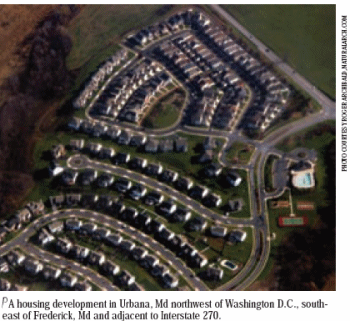SEJournal Online is the digital news magazine of the Society of Environmental Journalists. Learn more about SEJournal Online, including submission, subscription and advertising information.

Are Peak Oil, the subprime mortgage mess and generational shifts ending Americans’ love affair with the suburbs?
That’s what some high-profile urban planning types are postulating. It’s easy to understand how high gas prices could spur such thoughts. Plus, say those who have studied the demographics of housing, Gen Xers were never as enamored with the ‘burbs as Baby Boomers – and now, even empty-nester Boomers are casting a favorable glance toward the center city.
Meanwhile, the sea of “For sale” signs spawned by the mortgage meltdown threatens in some areas to make suburbs start looking more like slums, wrote Christopher B. Leinberger, a scholar at the Brookings Institution, in The Atlantic earlier this year.
Leinberger described a starter-home development in
Not all the hallmarks of this trend are so glum, though. I got interested in the back-to-the-city trend recently while chewing the fat with the head of a
Increasingly, homebuyers “don’t want to do that drive-‘til-you-can-afford-the-mortgage thing,” said Sam Anderson, executive director of the Master Builders Association of King and
In my own neighborhood, about two miles from downtown
But that’s not the only thing changing, in my neighborhood or others. We’re growing denser in many places, with all the lifestyle changes that implies. Not all that is going to the central city, either. It looks like some of that density is headed for the ‘burbs.
Reporters covering this story, Leinberger said in an interview, should bear in mind that patterns may not be the same from city to city. It’s not a matter of all Americans ending their love affair with all suburbs, he said.
“This is a transformation of some suburbs, and some suburbs will become slums,” he predicts. “It will be a tale of two suburbs. The ones that are car-dominated will have trouble.”
On the other hand, suburban areas served by mass transit, and particularly rail, are likely to prosper, Leinberger says. Look for walkable, urban neighborhoods – read that: dense neighborhoods – to spring up outside traditional center cities, he says, citing the
“Reporters should realize that, all around you, decisions are being made about how to grow,” says Arthur “Chris” Nelson, Presidential Professor of City and Metropolitan Planning at the
Nelson, who is appearing on a panel at this fall’s SEJ annual conference in
There’s pent-up demand among buyers, Leinberger says, for walkable urban neighborhoods. About a third of Americans would like to live in such a place, surveys show, but fewer than 10 percent of neighborhoods qualify.
Nelson echoes this, predicting a surplus of 22million large-lot homes – homes on one-sixth of an acre or more – by 2025. That’s equal to about two-fifths of all the homes on the ground today. Builders, though, are starting to pay close attention to the likes of Nelson, who predicts “fundamental changes” in the way cities are built.
Suburbs still have their defenders, to be sure. Probably the best-known is Joel Kotkin of southern
“My basic point is we’ve got another 100 million people coming – where are they going to go?” Kotkin said in an interview.
Even in cities, the desire for a more-suburban lifestyle can be found, Kotkin says, citing the example of neighborhoods in
Leinberger is sometimes painted as the polar opposite of Kotkin. But if you listen carefully, you can hear them both saying that at least some of the growth in jobs and development will be happening outside of central cities. Which suburbs survive and which become slums will help to shape the very face of our society.
A big question will be how the Gen Ys, a.k.a. the Millennials, will react as they start putting down roots in coming years. Some hypothesize Millennials are culturally more like the ‘Boomers than their immediate predecessors, Gen X. If that’s true, will they, too, head for the hills when it comes time to plunk down cash for a nest?
What’s happening in your town? It’s probably an engaging story. Possible spinoffs include: Changing commute times; greenhouse-gas production; the effect on the nuclear family; opportunities to preserve open space that once seemed sure to fall prey to sprawl. You can probably think of more.
Resources:
• See how walkable neighborhoods in your town are
• Arthur “Chris” Nelson: (801) 581-8253 or acnelson@utah.edu
• Christopher Leinberger: (202) 797-6215 or cleinberger@brookings.edu
• Joel Kotkin: (818) 766-6588 or JKotkin@JoelKotkin.com
Robert McClure covered growth in booming
** From SEJ's quarterly newsletter SEJournal, Fall 2008












 Advertisement
Advertisement 



